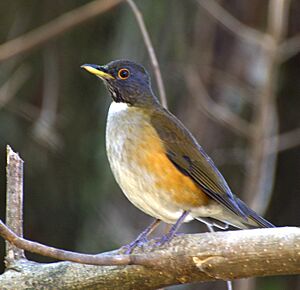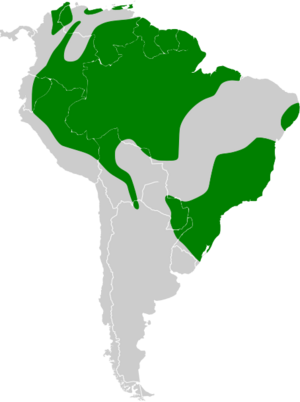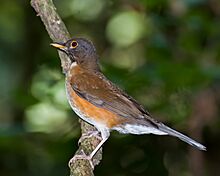White-necked thrush facts for kids
Quick facts for kids White-necked thrush |
|
|---|---|
 |
|
| The nominate subspecies in the São Paulo Forest Gardens, Brazil | |
| Conservation status | |
| Scientific classification | |
| Genus: |
Turdus
|
| Species: |
albicollis
|
 |
|
| Range of white-necked thrush (green) in South America | |
The white-necked thrush (Turdus albicollis) is a type of songbird. You can find it in forests and woodlands across South America. Scientists sometimes group it with other thrushes, which can make its family tree a bit tricky to understand!
Contents
What Does It Look Like?
This thrush is about 20.5 to 26 centimeters (8 to 10 inches) long. It weighs between 40 and 77 grams (1.4 to 2.7 ounces). Its top feathers are dark brown. They get a bit darker or grayer near its eyes.
The bird's throat is white with dark stripes. Below these stripes, there's a clear white crescent shape. This special mark gives the bird its name! The feathers around its tail base and the middle of its belly are whitish. Its chest is gray, sometimes with a brown tint.
Some white-necked thrushes have bright reddish-brown sides. Their beaks are yellow with a dark top part. Other types have paler, more yellowish-brown sides. Their beaks are almost entirely dark. All white-necked thrushes have pinkish-brown legs. They also have a reddish or yellow ring around their eyes. Both male and female birds look similar. Young birds are duller. They have dull orange spots on top and brownish spots underneath.
Sounds and Calls
The white-necked thrush sings a musical, often simple song. It sounds like "two-e-o, two-e". Its call is a clear "wuk". When it senses danger, it makes a rough "jjig-wig-wig" sound.
Where Does It Live?
You can find different groups of white-necked thrushes in various parts of South America. One group lives in eastern Brazil, northern Uruguay, eastern Paraguay, and northeastern Argentina. They mostly live in the Atlantic Forest.
Another group lives mainly in the Amazon Basin. They also live along the eastern side of the Andes mountains. You can find them as far south as northeastern Argentina. They also live as far north as western Venezuela. Some even live on the islands of Trinidad and Tobago. This group prefers the Amazon Rainforest or humid forests near mountains.
Both groups like humid forests and woodlands. These birds usually stay close to trees and bushes. They rarely go far out into open areas.
Behavior and Life Cycle
The white-necked thrush mostly eats on or near the ground. It loves to eat small creatures without backbones, like insects. It also eats some fruit, berries, and seeds. These birds often follow groups of army ants. The ants stir up insects, making them easy to catch.
This bird is usually shy, especially in the Amazon. You are more likely to hear it than see it. But in Trinidad and parts of southeastern Brazil, it can be less timid.
Nesting and Eggs
The white-necked thrush builds a cup-shaped nest. It lines the nest with twigs. The nest is usually placed low in a tree or bush. It can be anywhere from 1 to 9 meters (3 to 30 feet) high.
The female bird lays two or three eggs. The eggs are green-blue with reddish blotches. The female sits on the eggs alone for 12 to 13 days. They usually have one partner, but sometimes mate with others.
How Scientists Classify Them
Scientists sometimes group the white-necked thrush with another bird called the white-throated thrush. When they are grouped together, the combined species is called the white-throated thrush. But most scientists now think they are separate species.
Some people have also suggested that the white-necked thrush itself should be split into two different species. One would be the "rufous-flanked thrush." The other would be the "grey-flanked thrush." However, their songs are very similar. Also, some types of white-necked thrushes look like the "grey-flanked" group. This makes it hard to split them.





